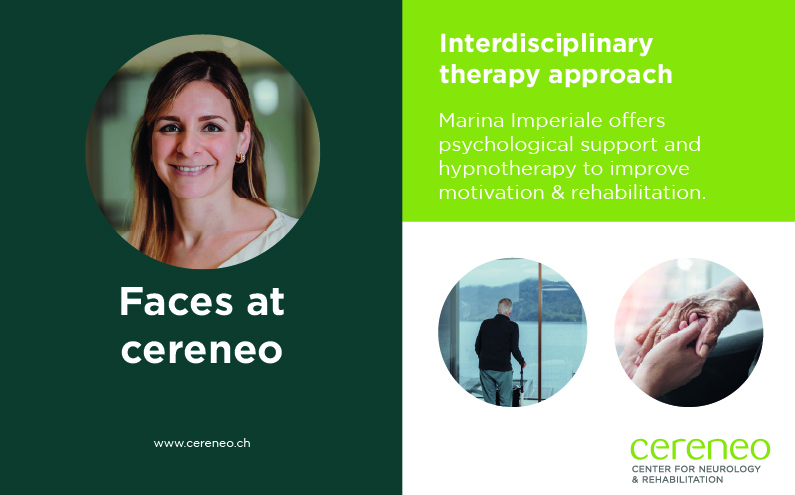Dr Marina Imperiale has been working at cereneo in her role as clinical psychologist since March 2023. Psychological support for patients and, in some cases, family members is an important part of the overall therapy and can have a significant impact on motivation and success. After her Master’s degree in clinical psychology and neuroscience, Marina completed her PhD in Mental Health and Psychotherapy Outcomes Research. During her studies, Marina worked part-time as a hypnotherapist. As a support to movement, speech and cognitive therapy, hypnosis can positively influence progress in rehabilitation.
How did you come to hypnosis as a form of therapy?
I grew up with hypnosis as a form of therapy from an early age, as my mother had been working as a clinical hypnotherapist for many years. I have therefore experienced the positive effects of clinical hypnotherapy on people for most of my life and was, so to speak, born with an interest and fascination for it. When I started studying psychology, I completed the basic training as a hypnotherapist so that I could work with it myself.
How can hypnosis support the rehabilitation of our patients?
Hypnosis has many uses, including supporting neurorehabilitation. Case studies using hypnosis in the context of neurorehabilitation after stroke date back to the 1950s. A report from Harvard and Massachusetts General Hospital (Diamond, David, Schaechter & Howe, 2006/Harvard University) summarised results from six case studies and concluded that there were qualitative improvements in motor function of the paretic upper extremity. In addition, patients reported other positive side effects, such as improved perspective and increased motivation. Furthermore, patients with neurological diseases often experience anxiety and depression symptoms and hypnosis can be very helpful here too.
To support movement therapy, exercises can be repeated during hypnosis. There are indications that this helps the brain to counteract the “learned non-use” of the paretic limb hereby leading to a better result in rehabilitation.
Can anyone be hypnotised?
In principle, yes. Anyone can go into a hypnotic state. Hypnosis is a natural state. Every day, people go into this state several times. For example, everyone knows the situation of having watched a very exciting film that lasted 1.5 hours and afterwards you have the feeling that it was only 5 minutes. Or, for example, when you are doing something that you enjoy very much and you «drift away» a little and an altered sense of time arises.
In which cases can hypnosis be recommended and in which would you not do it?
Basically nothing speaks against the use of hypnosis as a technique for psychological treatment. Of course, you always have to consider the individual and evaluate what is best for the patient. My approach is always tailored to the individual patient, as for me individuality is paramount and I want to take the unique nature of each person into account. At cereneo, we place great emphasis on tailoring therapies to the needs and goals of our patients.
How does a hypnosis session work exactly? How long does a treatment last? And how many treatments does a patient need?
First there is a preliminary discussion in which I find out more about the patient, their current situation, wishes and goals. In this process, I also use techniques from person-centred approaches to psychotherapy according to Carl Rogers, such as Motivational Interviewing.
In the preliminary talk I explain the hypnosis in order to clear up any fears or uncertainties. Afterwards, the hypnosis is initiated by so-called induction techniques. During this process, the patient enters a hypnotic state in which we then work specifically on the patient’s issue. The duration of the session can vary greatly, but is usually 45-50 minutes. The number of sessions needed depends greatly on the goal. There are goals such as smoking cessation that can be successfully achieved in 1-2 sessions and there are other topics that are accompanied over a longer period of time.
What exactly happens during hypnosis? How does it feel?
Hypnosis is derived from the ancient Greek word «hypnos», which means nothing other than sleep. Although hypnosis is a «sleep-like» state, you are not asleep. The similarity to sleep is that you are deeply relaxed. The difference with sleep is that in hypnosis you have a very focused attention where you work on something specific. Studies have found that brain regions of people in hypnosis are differently active and also differently interconnected. Learning and retention processes are highly active. Pain is also perceived differently under hypnosis, which is why hypnosis is often used in pain therapy, for example during operations or dental treatment.
Are there any risks or side effects that can occur during or after hypnosis?
Hypnosis has an effect and therefore a competent therapist is important. In therapeutic hypnosis there are no unwanted effects.
Show hypnosis is a completely different story. Personally, I cannot stand behind show hypnosis because the basic requirement of protecting the dignity of the human being cannot be guaranteed. Therefore, in the entertainment field, there is definitely a risk of undesirable effects when using hypnosis. In therapeutic hypnosis, however, there is no such risk.










